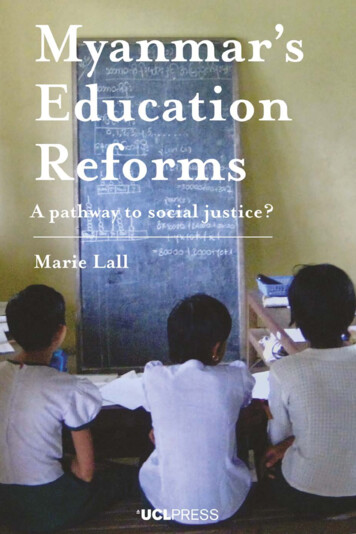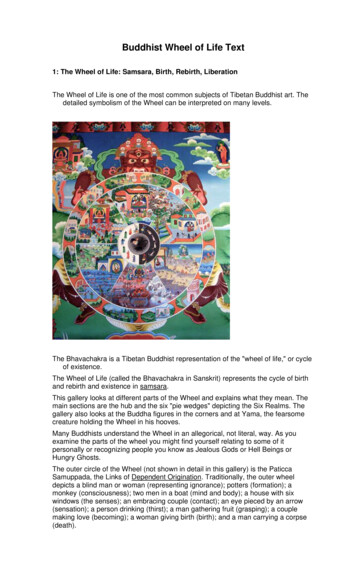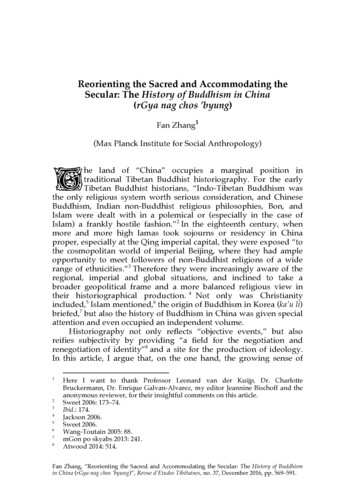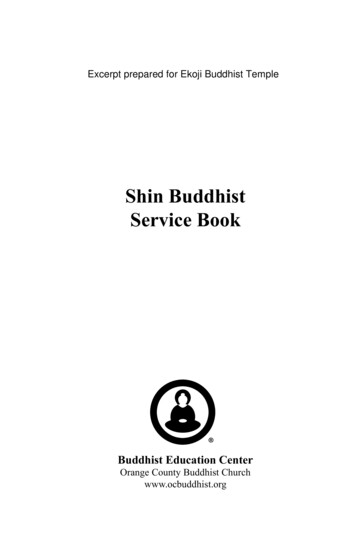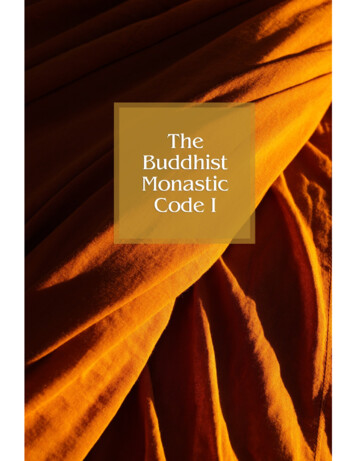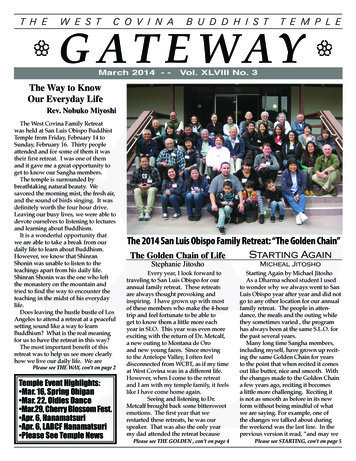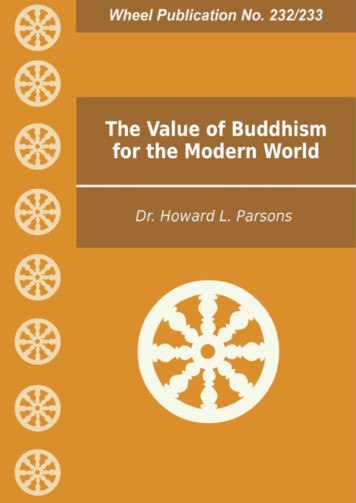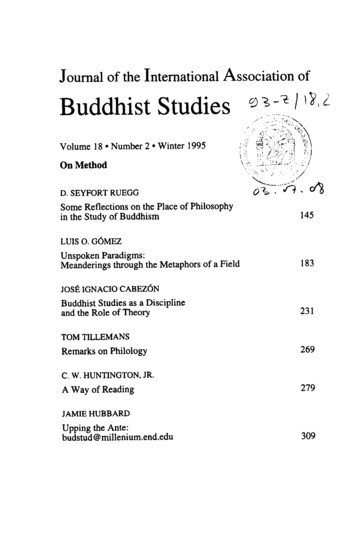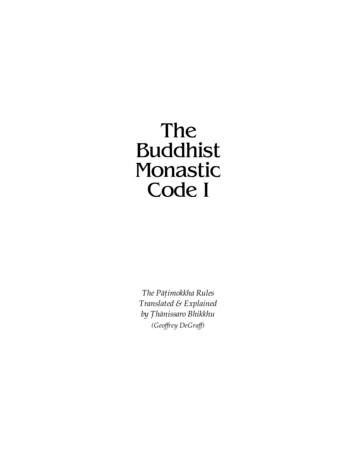
Transcription
TheBuddhistMonasticCode IThe P› imokkha RulesTranslated & Explainedby h›nissaro Bhikkhu(Geoffrey DeGraff)
2Inquiries concerning this bookmay be addressed to:The AbbotMetta Forest MonasteryP.O. Box 1409Valley Center, CA 92082 U.S.A.Copyright h›nissaro Bhikkhu 1994This book may be copied or reprintedfor free distributionwithout permission from the copyright holder.Otherwise, all rights reserved.Third edition, revised: 2013
3“Now, finanda, if it occurs to any of you—‘The teachinghas lost its arbitrator; we are without a Teacher’—do notview it in that way. Whatever Dhamma and Vinaya I havepointed out and formulated for you, that will be yourTeacher when I am gone.”—DN 16
4ContentsAbbreviationsPrefaceIntroduction: Dhamma-VinayaChapter 1: P› imokkhaChapter 2: NissayaChapter 3: DisrobingChapter 4: P›r›jikaChapter 5: Saºgh›disesaChapter 6: AniyataChapter 7: Nissaggiya P›cittiyaOne: The Robe-cloth ChapterTwo: The Silk ChapterThree: The Bowl ChapterChapter 8: P›cittiyaOne: The Lie ChapterTwo: The Living Plant ChapterThree: The Exhortation ChapterFour: The Food ChapterFive: The Naked Ascetic ChapterSix: The Alcoholic Drink ChapterSeven: The Animal ChapterEight: The In-accordance-with-the-Rule ChapterNine: The Valuable ChapterChapter 9: P› idesanıyaChapter 10: SekhiyaOne: Proper BehaviorTwo: FoodThree: Teaching DhammaFour: MiscellaneousChapter 11: Adhikara a-samathaChapter 12: Appendices
5I. Controversial points: Dawn & DawnriseII. Controversial points: Sugata measuresIII. Controversial points: MealsIV. Pali formulae: DeterminationV. Pali formulae: Shared ownershipVI. Pali formulae: ForfeitureVII. Pali formulae: ConfessionVIII. Pali formulae: Transaction statementsIX. Thullaccaya OffensesX. The pupil’s duties as attendant to his mentorGlossaryRule IndexSelect BibliographyAddendum
vNPPcPdPrPvSNSnSCSgSkThagVVismAºguttara Nik›yaAdhikara a-samathaAniyataBook of DisciplineThe Buddhist Monastic Code, vol. IThe Buddhist Monastic Code, vol. IICommentaryCariy›pi akaCullavaggaDıgha Nik›yaDhammapadaItivuttakaKaºkh›vitara ıKhuddakap› haMajjhima Nik›yaMah›vaggaNissaggiya P›cittiyaP›cittiyaP› idesanıyaP›r›jikaPariv›raSaªyutta Nik›yaSutta ›th›Vimati-vinodanıVisuddhimaggaNumbers in the references to Mv, Cv, and Pv denote chapter, section and subsection; in the references to DN, Iti, Khp, and MN, discourse (sutta); in thereferences to AN, Cp, SN, and Sn, section (saªyutta or nip›ta) and discourse; inthe references to Dhp, verse.
7PrefaceT HI S V O L U ME is the first in a two-volume book that attempts to give anorganized, detailed account of the Vinaya training rules and the traditions thathave grown up around them. The P› imokkha training rules as explained in theSutta Vibhaºga are the topic of the first volume; the rules found in theKhandhakas, the topic of the second. The book as a whole is aimed primarily atthose whose lives are affected by the rules—bhikkhus who live by them, andother people who have dealings with the bhikkhus—so that they will be able tofind gathered in one location as much essential information as possible on justwhat the rules do and do not entail. Students of Early Buddhism, Therav›dinhistory, or contemporary Therav›din issues should also find this bookinteresting, as should anyone who is serious about the practice of the Dhammaand wants to see how the Buddha worked out the ramifications of Dhammapractice in daily life.The amount of information offered here is both the book’s strength and itsweakness. On the one hand, it encompasses material that in some cases isotherwise unavailable in English or even in romanized Pali, and should besufficient to serve as a life-long companion to any bhikkhu who seriously wantsto benefit from the precise and thorough training the rules have to offer. On theother hand, the sheer size of the book and the mass of details to be rememberedmight prove daunting or discouraging to anyone just embarking on thebhikkhu’s life.To overcome this drawback, I have tried to organize the material in as clearcut a manner as possible. In particular, in volume one I have analyzed each ruleinto its component factors so as to show not only the rule’s precise range butalso how it connects to the general pattern of mindfully analyzing one’s ownactions in terms of such factors as intention, perception, object, effort, andresult—a system that plays an important role in the training of the mind. Involume two, I have gathered rules by subject so as to give a clear sense of howrules scattered randomly in the texts actually relate to one another in a coherentway.Secondly, in volume one I have provided short summaries for theP› imokkha rules and have gathered them, organized by topic, in the Rule Indexat the back of the volume. If you are new to the subject of Buddhist monasticdiscipline, I suggest that you read the Rule Index first, to grasp the gist of the mainrules and their relationship to the Buddhist path, before going on to the moredetailed discussions in the body of the book. This should help you keep thegeneral purpose of the rules in mind, and keep you from getting lost in the massof details.I am indebted to the many people who helped directly and indirectly in thewriting of this book. Phra Ajaan Fuang Jotiko (Phra Khru Ñ› avisitth) and PhraAjaan Thawng Candasiri (Phra Ñ› avisitth), my first teachers in Vinaya, gave
8me a thorough grounding in the subject. Ven. Brahmavaªso Bhikkhu gavemany hours of his time to writing detailed criticisms of early versions of themanuscript for the first edition of volume one, forcing me to deepen myknowledge and sharpen my presentation of the topic. As the manuscript of thefirst edition of that volume approached its final form, Ven. Phra Ñ› avarodom,Bhikkhu Bodhi, Thiradhammo Bhikkhu, Amaro Bhikkhu, Suviro Bhikkhu, BillWeir, and Doris Weir all read copies of it and offered valuable suggestions forimprovement.In the original conception of this book I planned only one volume, explainingthe P› imokkha rules. However, in 1997, Phra Ajaan Suwat Suvaco (PhraBodhidhamm›cariya Thera) convinced me that my work would not be completeuntil I had added the second volume, on the Khandhaka rules, as well. In thecourse of researching that volume, I had the opportunity to deepen myknowledge not only of the Khandhakas but also of areas in the Sutta Vibhaºgathat I had previously overlooked or misapprehended. Thus was born the ideafor the current revision. My aim in carrying it out has been twofold, both tocorrect errors and deficiencies in the first edition and to shape the two volumesinto a more coherent whole. This second aim has involved reorganizing thematerial and adopting a more consistent and accurate translation scheme fortechnical terms. The revision was given added impetus from the questions Ireceived from my students during Vinaya classes here at the monastery, andfrom a series of critiques and questions I received from bhikkhus in otherlocations. In addition to critiques from an anonymous group of bhikkhus in SriLanka, I also received critiques from Ven. Jotip›lo Bhikkhu, BrahmavaªsoBhikkhu, Brahm›li Bhikkhu, and the late Paññ›vu ho Bhikkhu on volume one,and an extended critique from Ven. Bhikkhu Ñ› atusita on volume two. All ofthese critiques, even in the many areas in which I disagreed with them, havehelped sharpen the focus of the book and made the presentation more accurateand complete. I am grateful for the time that my fellow bhikkhus have devotedto making this work more useful and reliable. Many lay people have providedhelp as well, in particular Thomas Patton, who provided references to theBurmese edition of the Canon, and Olivia Vaz and V.A. Ospovat, who helpedwith the proofreading. I, of course, remain responsible for any errors it may stillcontain.For anyone familiar with the first edition of this book, the most obviouschange will be the book’s increased size. This is the result of a felt need to makeits coverage more comprehensive. In the first instance, this has meant providinga more detailed account of the material in the Canon and commentaries. This inturn has uncovered more points where the commentaries conflict with theCanon, all of which required determining what seemed to be the most correctinterpretation of the points in question. I have also found it necessary to takeinto account the variant readings found in the four major editions of the Canon:Thai, Sri Lankan, Burmese, and European PTS. In the first edition of this book Ilimited my attention to the Thai edition, but I have since come to realize the needto sift through all four editions to find the best readings for the rules and theirexplanatory material. This point I discuss in detail in the Introduction to volume
9one. What it means in practice is that when the variant readings touch onimportant issues and would clearly make a practical difference, I have had todevote a fair amount of space to explaining my preference for one over theothers. At first I wanted to avoid dealing with these issues in the body of thebook, but given the still unsettled nature of our current knowledge of theCanon, I found them unavoidable. I hope that these discussions will not interferewith understanding the general thrust of each rule. Again, if you are new to thesubject of Buddhist monastic discipline, you can skip over these scholarlydiscussions during your first read-through. Then, when your knowledge of theVinaya is more solid and you feel so inclined, you can return to them at a latertime.Although my general policy has been to accept the most coherent readingregardless of which edition it appears in, I have had to depart from this policy inone area, that of the transaction statements used in Community meetings. Eachedition has its own standards for determining word order and orthography forthese statements, and in almost all cases these variant standards make nopractical difference. Thus, instead of trying to establish a preferred reading inevery case, I have—for consistency’s sake—followed the Thai standardthroughout, and have noted variants only where they seem important.One last practical note: Even though I have consulted all four major editionsof the Canon, I have provided reference numbers only to one—the PTSedition—as that is the edition most readily available to my readers. References tothe commentaries have been handled as follows: When, in the course ofdiscussing rule x, I cite the Commentary to rule x, I simply say, “TheCommentary says .” When I augment the discussion of rule x with a citationfrom the Commentary to rule y, I say, “The Commentary to rule y says .”These references may then be easily found in the area of the Commentarydevoted to the relevant rule, x or y, regardless of the edition consulted.When the first editions of volumes one and two were printed, the primarydedicatees were still alive. Both, however, have since passed away, but myrespect and gratitude to them have not diminished. So I now dedicate thevolumes to their memory. In the case of this first volume, that dedication is tothe memory of my preceptor, Phra Debmoli (Samrong Gu avu ho) of WatAsokaram, Samut Prakaan, Thailand, as well as to all my other teachers in thepath of the Dhamma-Vinaya. h›nissaro Bhikkhu(Geoffrey DeGraff)Metta Forest MonasteryValley Center, CA 92082-1409 U.S.A.May, 2007This third revised edition was inspired by questions from many of my fellowbhikkhus, in particular Vens. Nyanadhammo, Kevalı, Jotip›lo, Khematto, andKusalı.
10November, 2007
11INTRODUCTIONDhamma-VinayaDhamma-Vinaya was the Buddha’s own name for the religion he founded.Dhamma—the truth—is what he discovered and pointed out as advice for allwho want to gain release from suffering. Vinaya—discipline—is what heformulated as rules, ideals, and standards of behavior for those of his followerswho go forth from home life to take up the quest for release in greaterearnestness. Although this book deals primarily with discipline, we should noteat the outset that total training in the Buddha’s path requires that Dhamma andVinaya function together. In theory they may be separate, but in the person whopractices them they merge as qualities developed in the mind and character.“Gotamı, the qualities of which you may know, ‘These qualities lead todispassion, not to passion; to being unfettered and not to being fettered;to shedding and not to accumulating; to modesty and not to selfaggrandizement; to contentment and not to discontent; to seclusion andnot to entanglement; to aroused energy and not to laziness; to beingunburdensome and not to being burdensome’: You may definitely hold,‘This is the Dhamma, this is the Vinaya, this is the Teacher’sinstruction.’”—Cv.X.5Ultimately, the Buddha said, just as the sea has a single taste, that of salt, sotoo the Dhamma and Vinaya have a single taste: that of release. The connectionbetween discipline and release is spelled out in a passage that recurs at severalpoints in the Canon:“Discipline is for the sake of restraint, restraint for the sake of freedomfrom remorse, freedom from remorse for the sake of joy, joy for the sakeof rapture, rapture for the sake of tranquility, tranquility for the sake ofpleasure, pleasure for the sake of concentration, concentration for thesake of knowledge and vision of things as they have come to be,knowledge and vision of things as they have come to be for the sake ofdisenchantment, disenchantment for the sake of dispassion, dispassion forthe sake of release, release for the sake of knowledge and vision ofrelease, knowledge and vision of release for the sake of total unbindingthrough non-clinging.”—Pv.XII.2In establishing his religion of release, though, the Buddha did not simply setout a body of recommendations and rules. He also founded a company (paris›)of followers. This company falls into four main groups: bhikkhus (monks),
12bhikkhunıs (nuns), lay men, and lay women. Although the Buddha saw no needto organize the laity in any manner, he arranged for the bhikkhus andbhikkhunıs—who had given up the entanglements of the household life todevote themselves more fully to the goal of release—to develop intocommunities. And he saw that they needed, as all communities do, ideals andstandards, rules and customs to ensure their stability. This need is what gave riseto the Vinaya.In the early years of the Buddha’s career, the texts tell us, there was no needto formulate monastic disciplinary rules. All of the bhikkhus in his following—the Community of bhikkhunıs had not yet been started—were men of highpersonal attainments who had succeeded in subduing many or all of their mentaldefilements. They knew his teachings well and behaved accordingly. The Canontells of how Ven. S›riputta, one of the Buddha’s foremost disciples, asked theBuddha at an early date to formulate a P› imokkha, or code of rules, to ensurethat the celibate life the Buddha had founded would last long, just as a threadholding together a floral arrangement ensures that the flowers are not scatteredby the wind. The Buddha replied that the time for such a code had not yet come,for even the most backward of the men in the Community at that time hadalready had their first glimpse of the goal. Only when mental effluents (›sava)made themselves felt in the Community would there be a need for aP› imokkha.As time passed, the conditions that provided an opening for the effluentswithin the Community eventually began to appear. The Bhadd›li Sutta (MN 65)presents the Buddha at a later point in his career listing these conditions as five:Ven. Bhadd›li: “Why is it, venerable sir, that there used to be fewertraining rules and more bhikkhus established in the knowledge ofAwakening? And why is it that there are now more training rules andfewer bhikkhus established in the knowledge of Awakening?” [Bhadd›li,who has been unwilling to abide by the training rules, seems to besuggesting that the rise in the number of training rules is itself the causefor fewer bhikkhus’ attaining Awakening. The Buddha, however, offers adifferent explanation.]The Buddha: “So it is, Bhadd›li. When beings have begun todegenerate and the true Dhamma has begun to disappear, there are moretraining rules and fewer bhikkhus established in the knowledge ofAwakening. The Teacher does not lay down a training rule for hisdisciples as long as there are no cases where the conditions that offer afoothold for the effluents have arisen in the Community. But when thereare cases where the conditions that offer a foothold for the effluents havearisen in the Community, then the Teacher lays down a training rule forhis disciples so as to counteract those very conditions.“There are no cases where the conditions that offer a foothold for theeffluents have arisen in the Community as long as the Community hasnot become large. But when the Community has become large, then thereare cases where the conditions that offer a foothold for the effluents arise
13in the Community, and the Teacher then lays down a training rule for hisdisciples so as to counteract those very conditions. When theCommunity possesses great material gains. great status. a large body oflearning . When the Community is long-standing, then there are caseswhere the conditions that offer a foothold for the effluents arise in theCommunity, and the Teacher then lays down a training rule for hisdisciples so as to counteract those very conditions.”Thus the rules themselves were not the cause for degeneracy in theCommunity, and the conditions that provided a foothold for the effluents werenot themselves effluents. Rather, the growing complexity of the Communityprovided the opportunity for bhikkhus to act on the basis of their defilements ina growing variety of ways, and the rules—although they could not prevent anyof the five conditions—had to become correspondingly complex to counteractthe opportunities those conditions provided for unenlightened behavior.Even when these conditions did arise, though, the Buddha did not set out afull code at once. Instead, he formulated rules one at a time in response toevents. The considerations that went into formulating each rule are bestillustrated by the events surrounding the formulation of the first.Ven. Sudinna, the story goes, had strong faith in the Buddha and hadordained after receiving his parents’ grudging consent. He was their only childand, though married, was childless. His parents, fearing that the governmentwould confiscate their property at their death if it had no heir, devised variousschemes to lure Ven. Sudinna back to the lay life, but to no avail. Finally, hismother realized that he was firm in his intention to stay a bhikkhu and so askedhim at least to have intercourse with his former wife so that their propertywould have an heir. Ven. Sudinna consented, took his wife into the forest, andhad intercourse three times.Immediately he felt remorse and eventually confessed his deed to his fellowbhikkhus. Word reached the Buddha, who called a meeting of the Community,questioned Ven. Sudinna, and gave him a rebuke. The rebuke fell into two majorparts. In the first part, the Buddha reminded Ven. Sudinna of his position as asama a—a monk or contemplative—and that his behavior was unworthy of hisposition. Also, the Buddha pointed out to him the aims of the teaching and notedthat his behavior ran counter to them. The implication here was that Ven.Sudinna had not only acted inconsistently with the content of the teaching, buthad also shown callous disregard for the Buddha’s compassionate aims inmaking the Dhamma known.“‘Worthless man, it is unseemly, out of line, unsuitable, and unworthyof a contemplative; improper and not to be done . Haven’t I taught theDhamma in many ways for the sake of dispassion and not for passion; forunfettering and not for fettering; for freedom from clinging and not forclinging? Yet here, while I have taught the Dhamma for dispassion, youset your heart on passion; while I have taught the Dhamma for
14unfettering, you set your heart on being fettered; while I have taught theDhamma for freedom from clinging, you set your heart on clinging.“‘Worthless man, haven’t I taught the Dhamma in many ways for thefading of passion, the sobering of intoxication, the subduing of thirst, thedestruction of attachment, the severing of the round, the ending ofcraving, dispassion, cessation, unbinding? Haven’t I in many waysadvocated abandoning sensual pleasures, comprehending sensualperceptions, subduing sensual thirst, destroying sensual thoughts, calmingsensual fevers? Worthless man, it would be better that your penis be stuckinto the mouth of a poisonous snake than into a woman’s vagina. Itwould be better that your penis be stuck into the mouth of a black viperthan into a woman’s vagina. It would be better that your penis be stuckinto a pit of burning embers, blazing and glowing, than into a woman’svagina. Why is that? For that reason you would undergo death or deathlike suffering, but you would not on that account, at the break-up of thebody, after death, fall into a plane of deprivation, a bad destination, alower realm, hell. But for this reason you would, at the break-up of thebody, after death, fall into a plane of deprivation, a bad destination, alower realm, hell .“‘Worthless man, this neither inspires faith in the faithless norincreases the faithful. Rather, it inspires lack of faith in the faithless andwavering in some of the faithful.’”The second part of the rebuke dealt in terms of personal qualities: those that abhikkhu practicing discipline is to abandon, and those he is to develop.“Then the Blessed One, having in many ways rebuked Ven. Sudinna,having spoken in dispraise of being burdensome, demanding, arrogant,discontented, entangled, and indolent; in various ways having spoken inpraise of being unburdensome, undemanding, modest, content,scrupulous, austere, gracious, self-effacing, and energetic; having given aDhamma talk on what is seemly and becoming for bhikkhus, addressedthe bhikkhus.”This was where the Buddha formulated the training rule, after first stating hisreasons for doing so.“‘In that case, bhikkhus, I will formulate a training rule for the bhikkhuswith ten aims in mind: the excellence of the Community, the comfort ofthe Community, the curbing of the impudent, the comfort of wellbehaved bhikkhus, the restraint of effluents related to the present life, theprevention of effluents related to the next life, the arousing of faith in thefaithless, the increase of the faithful, the establishment of the trueDhamma, and the fostering of discipline.’”
15These reasons fall into three main types. The first two are external: 1) toensure peace and well being within the Community itself, and 2) to foster andprotect faith among the laity, on whom the bhikkhus depend for their support.(The origin stories of the various rules depict the laity as being very quick togeneralize. One bhikkhu misbehaves, and they complain, “How can theseSakyan-son monks do that?”) The third type of reason, though, is internal: Therule is to help restrain and prevent mental effluents within the individualbhikkhus. Thus the rules aim not only at the external well being of theCommunity but also at the internal well being of the individual. This latter pointsoon becomes apparent to anyone who seriously tries to keep to the rules, forthey foster mindfulness and circumspection in one’s actions, qualities that carryover into the training of the mind.Over the course of time the Buddha formulated more than 200 major andminor rules, forming the P› imokkha that was recited fortnightly in eachCommunity of bhikkhus. In addition, he formulated many other minor rulesthat were memorized by those of his followers who specialized in the subject ofdiscipline, but nothing is known for sure of what format they used to organizethis body of knowledge during his lifetime.After his total nibb›na, though, his followers made a concerted effort toestablish a standard canon of Dhamma and Vinaya, and the Pali Canon as weknow it began to take shape. The Vinaya was organized into two main parts: 1)the Sutta Vibhaºga, the ‘Exposition of the Text’ (which from here on we willrefer to simply as the Vibhaºga), containing almost all the material dealing withthe P› imokkha rules; and 2) the Khandhakas, or Groupings, which contain theremaining material organized loosely according to subject matter. TheKhandhakas themselves are divided into two parts, the Mah›vagga, or GreaterChapter, and the Cullavagga, or Lesser Chapter. Historians estimate that theVibhaºga and Khandhakas reached their present form in approximately the 2ndcentury B.C.E., and that the Pariv›ra, or Addenda—a summary and studyguide—was added a few centuries later, closing the Vinaya Pi aka, the part of theCanon dealing with discipline.Because the purpose of this volume is to translate and explain theP› imokkha, we are most directly concerned with the Vibhaºga. It is organizedas follows: The rules in the P› imokkha are presented one by one, each rulepreceded by an origin story relating the events leading up to its formulation. Insome instances a rule went through one or more reformulations, in which casean additional story is provided for each amendment to show what prompted it.With each new formulation of a rule, any previous formulations wereautomatically rescinded. Otherwise, the added restrictions or allowancescontained in the reformulations would have been rendered meaningless. Thus,the final formulation of the rule is the authoritative one, with the earlierformulations holding only historical interest.After the final statement of the rule is a word-analysis (pada-bh›janiya), whichexplains in detail most of the important terms in the rule. For many of the rulesthis analysis includes one or more “wheels,” or tables, giving the contingenciesconnected with the rule, working out all their possible permutations and passing
16judgment as to what penalty, if any, each permutation entails. For example, thediscussion of the first rule contains a wheel that gives all the objects with which aperson might have sexual intercourse, lists them against the variables of the sortof intercourse and whether or not the bhikkhu involved gives his consent, andannounces the penalty for each possible combination of factors.Following the word-analysis for each rule is a section of non-offense clauses,listing extenuating circumstances under which a bhikkhu would be exemptedfrom the penalty imposed by the rule.Finally, for the major rules, there is the Vinita-vatthu, or Precedents, listingvarious cases related to the rule and giving verdicts as to what penalty, if any,they entail.The Vibhaºga forms the basis for most of the explanations of the trainingrules given in this volume. However, there are many questions on which theVibhaºga is silent or unclear. To answer these questions, I have turned either tothe Khandhakas or to the commentarial literature that has grown up around theVinaya over the course of the centuries. The primary works I have consulted arethese:1) The Samanta-p›s›dik›—“The Thoroughly Inspiring”—(from here onreferred to as the Commentary), a commentary on the Vinaya Pi aka compiledin the 5th century C.E. by Bhadant›cariya Buddhaghosa, who based his work onancient commentaries. The originals for these ancient commentaries may havebeen brought to Sri Lanka from India and translated into Sinhalese, but frequentreferences throughout the commentaries to places and people in Sri Lanka showthat much of the material in the commentaries was composed in Sri Lanka. Frominternal evidence in Buddhaghosa’s writings—he compiled commentaries on amajor portion of the Canon—historians have estimated that the ancientcommentaries were collected over a span of several centuries and closed inapproximately the 4th century C.E. Buddhaghosa’s work thus contains materialmuch older than his date would indicate.By Buddhaghosa’s time a belief had grown up that the ancient commentarieswere the work of the Buddha’s immediate disciples and thus indisputablyconveyed the true intent of the Canon. However, as we shall see below, theancient commentaries themselves did not make such exalted claims forthemselves.Still, the existence of this belief in the 5th century placed certain constraints onBuddhaghosa’s work. At points where the ancient commentaries conflicted withthe Canon, he had to write the discrepancies off as copier’s mistakes or else sidewith the commentaries against the Canon. At a few points, such as hisexplanation of Pc 9, he provides arguments effectively demolishing the ancientcommentaries’ interpretation but then backs off, saying that the ancientcommentaries must be right because their authors knew the Buddha’s intentions.Perhaps pressure from the elder bhikkhus at the Mah›vih›ra in Anur›dhapura—the place where the ancient commentaries had been preserved and whereBuddhaghosa was allowed to do his work—was what made him back off in thisway. At any rate, only on points where the different ancient commentaries weresilent or gave divergent opinions did he feel free to express his own.
172) The Kaºkh›-vitara ı—“The Subjugator of Uncertainty”—(theK/Commentary), a commentary on the P› imokkha also compiled byBuddhaghosa. Although this work is largely a synopsis of material in theCommentary, it contains some independent material, in particular a system ofclassifying the offenses under each training rule into their component factors. Italso contradicts the Commentary from time to time, suggesting that it may havebeen based on a commentarial tradition different from the one underlying theCommentary.3) The S›rattha-dıpanı—“The Essence-Meaning Illustrator”—(the Subcommentary), a sub-commentary on the Commentary, written in Sri Lanka inthe 12th century C.E. by a Ven. S›riputta, the first Mah›s›min, or head of the SriLankan Saºg
BMC1 The Buddhist Monastic Code, vol. I BMC2 The Buddhist Monastic Code, vol. II C Commentary Cp Cariy›pi aka Cv Cullavagga DN Dıgha Nik›ya Dhp Dhammapada Iti Itivuttaka K Kaºkh›vitara ı Khp Khuddakap› ha MN Majjhima Nik›ya Mv Mah›vagga NP Nissaggiya P›cittiya Pc P›cittiya


